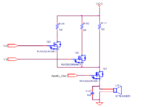Mandar Joshi
Member level 2
I am using KDMG20008 speaker for my project. The datasheet of speaker shows graph of frequency in Hz vs. sound in dB (Bode plot). However I am not able to pick the frequency from the plot for which gain is maximum. Can anyone tell me how to calculate divisions on X-axis or directly values of X-axis? The graph is as shown in image below.

Also datasheet is attached for more detail. Sorry, if I have posted in wrong forum.

Also datasheet is attached for more detail. Sorry, if I have posted in wrong forum.
